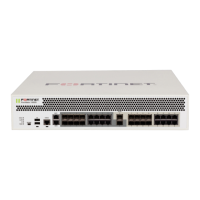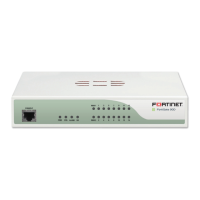260 01-28006-0003-20041105 Fortinet Inc.
Enabling PPTP and specifying a PPTP range VPN
4 Add a destination address for the firewall policy.
The destination addresses are the addresses to which the PPTP clients can connect.
For example, if the destination address is on the internal network, you would create an
external-to-internal policy to control the access that PPTP users have through the
FortiGate unit. Typically you would add only one destination address for the entire
internal subnetwork. See “To add an address” on page 200.
5 Add an external-to-internal firewall policy.
The firewall policy specifies the source and destination addresses and sets the
service for the policy to the traffic type inside the PPTP VPN tunnel. For example, if
you want PPTP clients to be able to access a web server, set the service to HTTP.
See “To add a firewall policy” on page 196.
6 Configure the Windows clients. See:
• Configuring a Windows 2000 client for PPTP.
• Configuring a Windows XP client for PPTP.
Enabling PPTP and specifying a PPTP range
The PPTP address range is the range of addresses reserved for remote PPTP clients.
When a remote PPTP client connects to the internal network using PPTP, the client
computer is assigned an IP address from this range. The PPTP address range can be
on any subnet.
Figure 133:PPTP range
To enable PPTP on the FortiGate unit
1 Go to VPN > PPTP > PPTP Range.
2 Select Enable PPTP.
3 Complete the fields as required.
4 Select Apply.
Enable PPTP You must add a user group before you can enable this option.
Starting IP The start of the IP range. For example, 192.168.1.10.
Ending IP The end of the IP range. For example, 192.168.1.20.
User Group Select the user group that contains the remote PPTP VPN clients.
Disable PPTP Select this option to disable the PPTP support.

